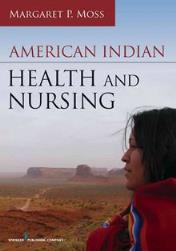 | American Indian Health and Nursing Springer Publishing Company, 2016 |
When I was approached to write a book review on American Indian Health and Nursing, I was apprehensive: Was this text just another 'how to' manual written by non-Aboriginal people, another Trojan horse of colonization under the guise of healthcare provision? Imagine my pleasant surprise when I found that this book was edited by Margaret P. Moss, an accomplished nurse who is herself Aboriginal, and that chapters are authored primarily by Aboriginal authors. That this book is written by and for nurses who work with Aboriginal people is clinically and ethically significant.
This book is divided into three sections. The first section provides important historical and contextual perspectives on American Indians and their health. Moss presents a compelling discussion about post-contact impacts and their ripple effects on the health of Aboriginal peoples that endure to this day. The current day Indian Health System in the US is clearly and succinctly described, which provides an excellent overview for those beginning to work in these settings.
The second section presents an overview of 10 Aboriginal cultural groups in the US. Given that there are 566 Indian entities recognized by the US Bureau of Indian Affairs, the editor made a pragmatic decision to increase the utility of the text without reducing all Aboriginal cultures to a short list of essentialized features - a trait all too common in Western texts. Chapter by chapter, each of these cultural groups is overviewed, including regional and tribal history, demographics, health disparities, health care, and socioeconomics. Embedded nursing stories and examples give each chapter a strong relevance to nursing practice. An unexpected gem was a chapter on urban American Indians. By understanding urban Aboriginals as a distinct cultural group, the reader gains a heightened awareness of Aboriginal migration to urban settings, the formation of an urban cultural Indian identity, and related health and health service implications.
The third section addresses policy and funding issues - and why change is needed in both to address growing health disparities - and the future of nursing. In short, health, education, and social policy must be shaped 'with the Indigenous voice' (p. 350) if headway is to be made in the health of Aboriginal people.
Some of the editorial perks within this book are: occasional personal stories; respectful attribution of sources of Indigenous knowledge; critical thinking exercises; study questions; useful websites; and recommended readings.
My primary criticism of this text is that at times, the narrative was sprinkled with numerical data or direct (often unedited) quotes that I thought detracted from the flow of the text. At other times, the narrative contained content that I thought might be either subject to imminent change or too detailed. While the narrative definitely whet my appetite for more information or another story from the trenches, at times I was left wanting. However, these complaints are small, and I am sure they will be remedied in the second edition.
As a nurse and educator, I can attest that this book is an important one for anyone working as a nurse in the US - and especially for those working with and among American Indians.
Em Pijl-Zieber
Faculty of Health Sciences
University of Lethbridge
Lethbridge, Alberta, Canada
